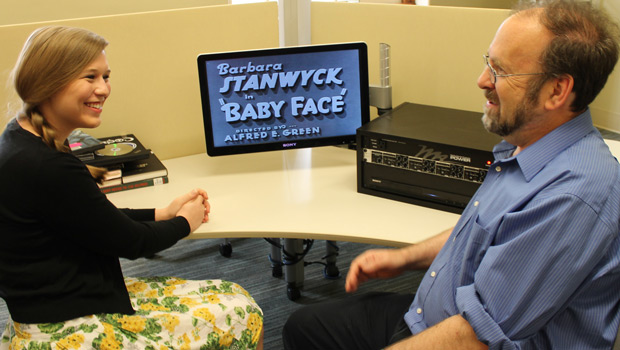
Lizzie Woods, a senior from Stuart, Fla., spent 10 weeks researching 20th century censorship and the Hollywood Production Code with Scott Klein, chair of the English department. Originally interested in book censorship, Woods found herself intrigued by Klein’s research in the film field and soon learned that during the 1930s, film censorship was getting stricter while books were more becoming more obscene.
Q: What was a typical day in your research project?
A: I spent most of my day in the DVD viewing room. Typically I watched one to two movies a day, depending on my list for the week and what films I was able to find in both the pre- and post-code versions. The library faculty was so helpful; I never had an issue getting any type of media whether it was a book, article or DVD.
I watched the films on the big screens while taking notes on what was removed between the pre- and post-censored films. I would note how these changes affected the overall tone and audience response to the films.
I did additional research of my own on book censorship because I was interested in the comparison. The peripheral research was about how books were re-legalized after being banned. Books such as “Lolita” and “Ulysses” were reintroduced to the public while the censorship of film was being tightened, so some of my research was on why production studios agreed to censorship. I also spent time in the government section, researching censorship legislation during this time.
Q: How do the pre-code films from the 1930s compare to today’s films?
A: The Hollywood Production Code of 1930 was not enforced until 1934, so I mostly watched films between 1930 until 1934. It was interesting to watch the pre-code and censored films side by side.
The pre-code films I watched would shock people today. They were suggestive and provocative, and flaunted sexual promiscuity, crime and dishonesty.
I watched these films and applied modern-day terms. Film was only about 10 years old at the time and now daily use of the Internet is about 15 years old, which is an interesting comparison because censorship battles are still top of mind today.
Q: Did any of the films become a favorite?
A: My favorite of the films was a 1933 film titled “Baby Face.” The plot follows the exploits of the main character, Lily, who uses her good looks and charm to manipulate men and advance her social standing. This particular film is one of the few that I had the good fortune of finding both the original and censored versions, and the changes made to the film following the Production Code’s enforcement are subtle, but have a profound effect on the film’s message.
By removing a few suggestive scenes, manipulating the dialogue, and adding an alternate ending, those who censored “Baby Face” transformed the film from a provocative and entertaining story to a cautionary tale, warning young women that exploiting one’s sexuality will only lead to moral ruin – or worse. It’s astounding how much a small amount of censorship can affect the entire tone of a scene or even the film as a whole.
Q: How has your research experience affected future career plans?
A: I am fascinated by the government’s involvement in media, specifically the ethical and moral censorship of media and the gray area of what is acceptable for public consumption. Wake Forest has fostered all my interests and ultimately led my decisions from what I should major in to my future career path in studying law and hopefully making a difference as far as censorship.
I can’t think of another university where you have that sense of community between faculty and students. I am grateful to Wake Forest, my mentor and the URECA Center for the summer research experience, which has enabled me to find my passion.
Categories: For Alumni, For Parents, Research, Student, Top Stories, Wake Forest College
Headlines
Wake Forest in the News
Wake Forest regularly appears in media outlets around the world.




